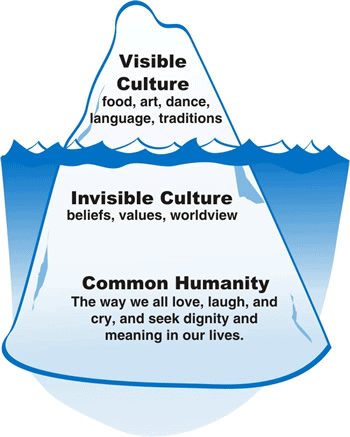
There is a great risk to fail to acquire the values and assumptions behind a language. Speaking the language, which is on the borderline between the visible and invisible aspects of a culture, is often not enough. It is also possible for the interpretations of the individual members of a group to be radically different from one another. Cultures often contain conflicting or mutually exclusive messages that require constant interpretation. Some of the elements of this system of beliefs can be obvious, others are hidden.
#ICEBERG MODEL OF CULTURE EXAMPLES HOW TO#
To put it in the words some modern theorists, culture is a complex set of shared beliefs, values and ideas that help a group "understand" the life around and tells them how to live. Edgar Schein, for example, proposes a similar three-level model of organizational culture which includes (top to bottom) artifacts, values and basic assumptions. Hall’s triad of culture refers to cultures in broad terms but it has an analogue in the study of organizational culture. However, when this tacit etiquette is breached, a person responds emotionally. As Hall puts it, there is little or no affect attached to informal behaviour as long as things are going along nicely according to the unwritten or unstated rules. There are no rules at this level and it is acquired informally. The third level (the second one below the water line) is called informal culture. Formal culture is the most difficult to change but it does evolve slowly over time.

However, when the convention is violated, this arouses deep emotions. In general, people are not aware of the conventions surrounding the routines of life. Traditions, for example, inhabit this level. It represents the accepted way to do things and is not objective. The second level (the first one below the water line) is called formal culture. However, violating these rules can lead to strong emotional reactions. They are the easiest to change due to influences from the outside.


They are usually associated with codified rules and laws. These elements of a culture are explicit. Thus the level above the waterline is called technical culture. Hall goes further by dividing the “iceberg” in three and calls it the Triad of Culture (1959, pp. The elements which inhabit the space close to the iceberg base are considered most difficult to change.Į. – 1995, Katan - 2014) liken culture to an iceberg – there are elements which we can see clearly but many more are “below the waterline” and we can only guess or judge about them on the basis of what we see above the water surface. A popular metaphor about culture likens it to an iceberg with a small visible and a much larger invisible part.


 0 kommentar(er)
0 kommentar(er)
